- Home
- Ursula K. Le Guin
The Left Hand of Darkness
The Left Hand of Darkness Read online
From field notes of Ong Tot Oppong, Investigator, of the first Ekumenical landing party of Gethen/Winter, Cycle 93 E.Y. 1448
Our entire pattern of socio-sexual interaction is nonexistent here. The Gethenians do not see one another as men or women. This is almost impossible for our imaginations to accept. After all, what is the first question we ask about a newborn baby?
Yet you cannot think of a Gethenian as “it.” They are not neuters. They are potentials; during each sexual cycle they may develop in either direction for the duration of that cycle. No physiological habit is established, and the mother of several children may be the father of several more.
There is no division of humanity into strong and weak halves, protected/protective. One is respected and judged only as a human being. You cannot cast a Gethenian in the role of Man or Woman, while adopting towards “him” a corresponding role dependent on your expectations of the interactions between persons of the same or opposite sex. It is an appalling experience for a Terran…
Ace Books by Ursula K. Le Guin
CITY OF ILLUSIONS
THE LEFT HAND OF DARKNESS
PLANET OF EXILE
ROCANNON’S WORLD
MALAFRENA
with Virginia Kidd
INTERFACES
THE LEFT HAND OF DARKNESS
An Ace Book / published by arrangement with
the author
PRINTING HISTORY
Ace edition / March 1969
All rights reserved.
Copyright © 1969 by Ursula K. Le Guin.
Introduction copyright © 1976 by Ursula K. Le Guin.
This book may not be reproduced in whole or in part,
by mimeograph or any other means. without permission.
For information address: The Berkley Publishing Group,
200 Madison Avenue. New York. New York 10016.
ISBN: 0-441-47812-3
Ace Books are published by The Berkley Publishing Group,
200 Madison Avenue, New York, New York 10016.
The name “ACE” and the “A” logo
are trademarks belonging to
Charter Communications, Inc.
PRINTED IN THE UNITED STATES OF AMERICA
49 48 47 46 45 44 43 42 41 40
DEDICATION:
For Charles
sine quo non
URSULA KROEBER LE GUIN, daughter of A. L. Kroeber (anthropologist) and Theodora Kroeber (author), was born in Berkeley, California, in 1929. She attended college at Radcliffe and Columbia, and married C. A. Le Guin in Paris in 1951. The Le Guins and their three children live in Portland, Oregon.
Ursula K. Le Guin’s novels include ROCANNON’S WORLD, PLANET OF EXILE, CITY OF ILLUSIONS and THE LEFT HAND OF DARKNESS, all published by Ace Books. THE LEFT HAND OF DARKNESS in particular attracted wide attention and strong praise; it was awarded both the Nebula and the Hugo Awards.
With the awarding of the 1975 Hugo and Nebula Awards to THE DISPOSSESSED, Ursula K. Le Guin became the first author to win both awards twice for novels.
CONTENTS
Introduction
A Parade in Erhenrang
The Place Inside the Blizzard
The Mad King
The Nineteenth Day
The Domestication of Hunch
One Way into Orgoreyn
The Question of Sex
Another Way into Orgoreyn
Estraven the Traitor
Conversations in Mishnory
Soliloquies in Mishnory
On Time and Darkness
Down on the Farm
The Escape
To the Ice
Between Drumner and Dremegole
An Orgota Creation Myth
On the Ice
Homecoming
A Fool’s Errand
The Gethenian Calendar and Clock
Introduction
Science fiction is often described, and even defined, as extrapolative. The science fiction writer is supposed to take a trend or phenomenon of the here-and-now, purify and intensify it for dramatic effect, and extend it into the future. “If this goes on, this is what will happen.” A prediction is made. Method and results much resemble those of a scientist who feeds large doses of a purified and concentrated food additive to mice, in order to predict what may happen to people who eat it in small quantities for a long time. The outcome seems almost inevitably to be cancer. So does the outcome of extrapolation. Strictly extrapolative works of science fiction generally arrive about where the Club of Rome arrives: somewhere between the gradual extinction of human liberty and the total extinction of terrestrial life.
This may explain why many people who do not read science fiction describe it as “escapist,” but when questioned further, admit they do not read it because “it’s so depressing.”
Almost anything carried to its logical extreme becomes depressing, if not carcinogenic.
Fortunately, though extrapolation is an element in science fiction, it isn’t the name of the game by any means. It is far too rationalist and simplistic to satisfy the imaginative mind, whether the writer’s or the reader’s. Variables are the spice of life.
This book is not extrapolative. If you like you can read it, and a lot of other science fiction, as a thought-experiment. Let’s say (says Mary Shelley) that a young doctor creates a human being in his laboratory; let’s say (says Philip K. Dick) that the Allies lost the second world war; let’s say this or that is such and so, and see what happens…In a story so conceived, the moral complexity proper to the modern novel need not be sacrificed, nor is there any built-in dead end; thought and intuition can move freely within bounds set only by the terms of the experiment, which may be very large indeed.
The purpose of a thought-experiment, as the term was used by Schrödinger and other physicists, is not to predict the future—indeed Schrödinger’s most famous thought-experiment goes to show that the “future,” on the quantum level, cannot be predicted—but to describe reality, the present world.
Science fiction is not predictive; it is descriptive.
Predictions are uttered by prophets (free of charge); by clairvoyants (who usually charge a fee, and are therefore more honored in their day than prophets); and by futurologists (salaried). Prediction is the business of prophets, clairvoyants, and futurologists. It is not the business of novelists. A novelist’s business is lying.
The weather bureau will tell you what next Tuesday will be like, and the Rand Corporation will tell you what the twenty-first century will be like. I don’t recommend that you turn to the writers of fiction for such information. It’s none of their business. All they’re trying to do is tell you what they’re like, and what you’re like—what’s going on—what the weather is now, today, this moment, the rain, the sunlight, look! Open your eyes; listen, listen. That is what the novelists say. But they don’t tell you what you will see and hear. All they can tell you is what they have seen and heard, in their time in this world, a third of it spent in sleep and dreaming, another third of it spent in telling lies.
“The truth against the world!”—Yes. Certainly. Fiction writers, at least in their braver moments, do desire the truth: to know it, speak it, serve it. But they go about it in a peculiar and devious way, which consists in inventing persons, places, and events which never did and never will exist or occur, and telling about these fictions in detail and at length and with a great deal of emotion, and then when they are done writing down this pack of lies, they say, There! That’s the truth!
They may use all kinds of facts to support their tissue of lies. They may describe the Marshalsea Prison, which was a real place, or the battle of Borodino, which really was fought, or the process of cloning, wh
ich really takes place in laboratories, or the deterioration of a personality, which is described in real textbooks of psychology; and so on. This weight of verifiable place-event-phenomenon-behavior makes the reader forget that he is reading a pure invention, a history that never took place anywhere but in that unlocalisable region, the author’s mind. In fact, while we read a novel, we are insane—bonkers. We believe in the existence of people who aren’t there, we hear their voices, we watch the battle of Borodino with them, we may even become Napoleon. Sanity returns (in most cases) when the book is closed.
Is it any wonder that no truly respectable society has ever trusted its artists?
But our society, being troubled and bewildered, seeking guidance, sometimes puts an entirely mistaken trust in its artists, using them as prophets and futurologists.
I do not say that artists cannot be seers, inspired: that the awen cannot come upon them, and the god speak through them. Who would be an artist if they did not believe that that happens? if they did not know it happens, because, they have felt the god within them use their tongue, their hands? Maybe only once, once in their lives. But once is enough.
Nor would I say that the artist alone is so burdened and so privileged. The scientist is another who prepares, who makes ready, working day and night, sleeping and awake, for inspiration. As Pythagoras knew, the god may speak in the forms of geometry as well as in the shapes of dreams; in the harmony of pure thought as well as in the harmony of sounds; in numbers as well as in words.
But it is words that make the trouble and confusion. We are asked now to consider words as useful in only one way: as signs. Our philosophers, some of them, would have us agree that a word (sentence, statement) has value only in so far as it has one single meaning, points to one fact which is comprehensible to the rational intellect, logically sound, and—ideally—quantifiable.
Apollo, the god of light, of reason, of proportion, harmony, number—Apollo blinds those who press too close in worship. Don’t look straight at the sun. Go into a dark bar for a bit and have a beer with Dionysios, every now and then.
I talk about the gods, I am an atheist. But I am an artist too, and therefore a liar. Distrust everything I say. I am telling the truth.
The only truth I can understand or express is, logically defined, a lie. Psychologically defined, a symbol. Aesthetically defined, a metaphor.
Oh, it’s lovely to be invited to participate in Futurological Congresses where Systems Science displays its grand apocalyptic graphs, to be asked to tell the newspapers what America will be like in 2001, and all that, but it’s a terrible mistake. I write science fiction, and science fiction isn’t about the future. I don’t know any more about the future than you do, and very likely less.
This book is not about the future. Yes, it begins by announcing that it’s set in the “Ekumenical Year 1490-97,” but surely you don’t believe that?
Yes, indeed the people in it are androgynous, but that doesn’t mean that I’m predicting that in a millennium or so we will all be androgynous, or announcing that I think we damned well ought to be androgynous. I’m merely observing, in the peculiar, devious, and thought-experimental manner proper to science fiction, that if you look at us at certain odd times of day in certain weathers, we already are. I am not predicting, or prescribing. I am describing. I am describing certain aspects of psychological reality in the novelist’s way, which is by inventing elaborately circumstantial lies.
In reading a novel, any novel, we have to know perfectly well that the whole thing is nonsense, and then, while reading, believe every word of it. Finally, when we’re done with it, we may find—if it’s a good novel—that we’re a bit different from what we were before we read it, that we have been changed a little, as if by having met a new face, crossed a street we never crossed before. But it’s very hard to say just what we learned, how we were changed.
The artist deals with what cannot be said in words.
The artist whose medium is fiction does this in words. The novelist says in words what cannot be said in words.
Words can be used thus paradoxically because they have, along with a semiotic usage, a symbolic or metaphoric usage. (They also have a sound—a fact the linguistic positivists take no interest in. A sentence or paragraph is like a chord or harmonic sequence in music: its meaning may be more clearly understood by the attentive ear, even though it is read in silence, than by the attentive intellect).
All fiction is metaphor. Science fiction is metaphor. What sets it apart from older forms of fiction seems to be its use of new metaphors, drawn from certain great dominants of our contemporary life—science, all the sciences, and technology, and the relativistic and the historical outlook, among them. Space travel is one of these metaphors; so is an alternative society, an alternative biology; the future is another. The future, in fiction, is a metaphor.
A metaphor for what?
If I could have said it non-metaphorically, I would not have written all these words, this novel; and Genly Ai would never have sat down at my desk and used up my ink and typewriter ribbon in informing me, and you, rather solemnly, that the truth is a matter of the imagination.
Ursula K. Le Guin
1. A Parade in Erhenrang
From the Archives of Hain. Transcript of Ansible Document 01-01101-934-2-Gethen: To the Stabile on Ollul: Report from Genly Ai, First Mobile on Gethen/Winter, Hainish Cycle 93, Ekumenical Year 1490-97.
I’LL MAKE my report as if I told a story, for I was taught as a child on my homeworld that Truth is a matter of the imagination. The soundest fact may fail or prevail in the style of its telling: like that singular organic jewel of our seas, which grows brighter as one woman wears it and, worn by another, dulls and goes to dust. Facts are no more solid, coherent, round, and real than pearls are. But both are sensitive.
The story is not all mine, nor told by me alone. Indeed I am not sure whose story it is; you can judge better. But it is all one, and if at moments the facts seem to alter with an altered voice, why then you can choose the fact you like best; yet none of them are false, and it is all one story.
It starts on the 44th diurnal of the Year 1491, which on the planet Winter in the nation Karhide was Odharhahad Tuwa or the twenty-second day of the third month of spring in the Year One. It is always the Year One here. Only the dating of every past and future year changes each New Year’s Day, as one counts backwards or forwards from the unitary Now. So it was spring of the Year One in Erhenrang, capital city of Karhide, and I was in peril of my life, and did not know it.
I was in a parade. I walked just behind the gossiwors and just before the king. It was raining.
Rainclouds over dark towers, rain falling in deep streets, a dark storm-beaten city of stone, through which one vein of gold winds slowly. First come merchants, potentates, and artisans of the City Erhenrang, rank after rank, magnificently clothed, advancing through the rain as comfortably as fish through the sea. Their faces are keen and calm. They do not march in step. This is a parade with no soldiers, not even imitation soldiers.
Next come the lords and mayors and representatives, one person, or five, or forty-five, or four hundred, from each Domain and Co-Domain of Karhide, a vast ornate procession that moves to the music of metal horns and hollow blocks of bone and wood and the dry, pure lilting of electric flutes. The various banners of the great Domains tangle in a rain-beaten confusion of color with the yellow pennants that bedeck the way, and the various musics of each group clash and interweave in many rhythms echoing in the deep stone street.
Next, a troop of jugglers with polished spheres of gold which they hurl up high in flashing flights, and catch, and hurl again, making fountain-jets of bright jugglery. All at once, as if they had literally caught the light, the gold spheres blaze bright as glass: the sun is breaking through.
Next, forty men in yellow, playing gossiwors. The gossiwor, played only in the king’s presence, produces a preposterous disconsolate bellow. Forty of them played together shake one�
��s reason, shake the towers of Erhenrang, shake down a last spatter of rain from the windy clouds. If this is the Royal Music no wonder the kings of Karhide are all mad.
Next, the royal party, guards and functionaries and dignitaries of the city and the court, deputies, senators, chancellors, ambassadors, lords of the Kingdom, none of them keeping step or rank yet walking with great dignity; and among them is King Argaven XV, in white tunic and shirt and breeches, with leggings of saffron leather and a peaked yellow cap. A gold finger-ring is his only adornment and sign of office. Behind this group eight sturdy fellows bear the royal litter, rough with yellow sapphires, in which no king has ridden for centuries, a ceremonial relic of the Very-Long-Ago. By the litter walk eight guards armed with “foray guns,” also relics of a more barbaric past but not empty ones, being loaded with pellets of soft iron. Death walks behind the king. Behind death come the students of the Artisan Schools, the Colleges, the Trades, and the King’s Hearths, long lines of children and young people in white and red and gold and green; and finally a number of soft-running, slow, dark cars end the parade.
The royal party, myself among them, gather on a platform of new timbers beside the unfinished Arch of the River Gate. The occasion of the parade is the completion of that arch, which completes the new Road and River Port of Erhenrang, a great operation of dredging and building and roadmaking which has taken five years, and will distinguish Argaven XV’s reign in the annals of Karhide. We are all squeezed rather tight on the platform in our damp and massive finery. The rain is gone, the sun shines on us, the splendid, radiant, traitorous sun of Winter. I remark to the person on my left, “It’s hot. It’s really hot.”

 Catwings
Catwings Tehanu
Tehanu The Tombs of Atuan
The Tombs of Atuan A Wizard of Earthsea
A Wizard of Earthsea The Other Wind
The Other Wind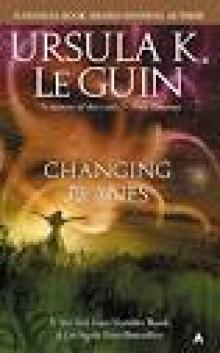 Ursula K. Le Guin
Ursula K. Le Guin Dangerous People
Dangerous People Worlds of Exile and Illusion: Rocannon's World, Planet of Exile, City of Illusions
Worlds of Exile and Illusion: Rocannon's World, Planet of Exile, City of Illusions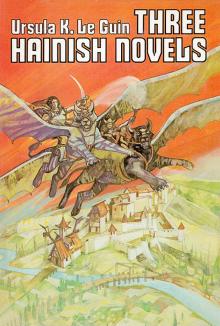 Three Hainish Novels
Three Hainish Novels The Left Hand Of Darkness (SF Masterworks)
The Left Hand Of Darkness (SF Masterworks) The Unreal and the Real - Vol 1 - Where On Earth
The Unreal and the Real - Vol 1 - Where On Earth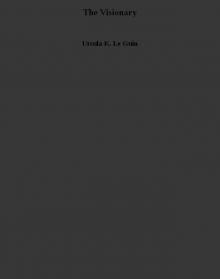 The Visionary
The Visionary The Ones Who Walk Away from Omelas
The Ones Who Walk Away from Omelas The Word for World is Forest
The Word for World is Forest Always Coming Home
Always Coming Home The Unreal and the Real - Vol 2 - Outer Space, Inner Lands
The Unreal and the Real - Vol 2 - Outer Space, Inner Lands Malafrena
Malafrena The Lathe of Heaven
The Lathe of Heaven Five Ways to Forgiveness
Five Ways to Forgiveness The Eye of the Heron
The Eye of the Heron Four Ways to Forgiveness
Four Ways to Forgiveness Powers
Powers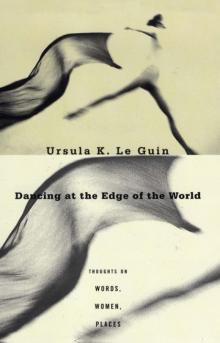 Dancing at the Edge of the World
Dancing at the Edge of the World Very Far Away from Anywhere Else
Very Far Away from Anywhere Else Voices aotws-2
Voices aotws-2 The New Atlantis
The New Atlantis The Unreal and the Real, Selected Stories of Ursula K. Le Guin Volume 1: Where on Earth
The Unreal and the Real, Selected Stories of Ursula K. Le Guin Volume 1: Where on Earth The Telling
The Telling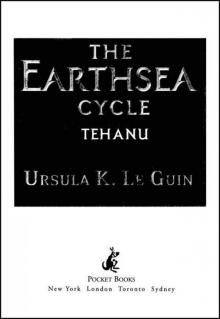 Tehanu (Earthsea Cycle)
Tehanu (Earthsea Cycle) Nine Lives twtq-9
Nine Lives twtq-9 The Birthday of the World and Other Stories
The Birthday of the World and Other Stories The Dispossessed
The Dispossessed Changing Planes
Changing Planes Words Are My Matter
Words Are My Matter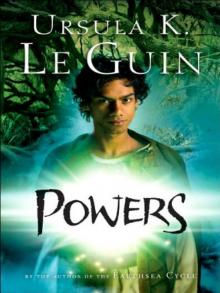 Powers aotws-3
Powers aotws-3 Lavinia
Lavinia The Wind's Twelve Quarters
The Wind's Twelve Quarters Orsinian Tales
Orsinian Tales Gifts aotws-1
Gifts aotws-1 Coming of Age in Karhide
Coming of Age in Karhide The Books of Earthsea: The Complete Illustrated Edition
The Books of Earthsea: The Complete Illustrated Edition The Found and the Lost
The Found and the Lost No Time to Spare
No Time to Spare Voices
Voices The Wild Girls
The Wild Girls Old Music and the Slave Women
Old Music and the Slave Women The Daughter of Odren
The Daughter of Odren A Fisherman of the Inland Sea: Stories
A Fisherman of the Inland Sea: Stories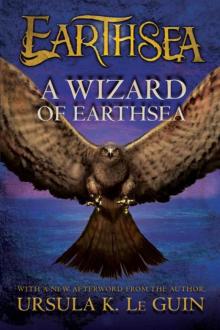 A Wizard of Earthsea (The Earthsea Cycle)
A Wizard of Earthsea (The Earthsea Cycle)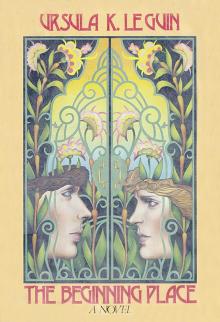 The Beginning Place
The Beginning Place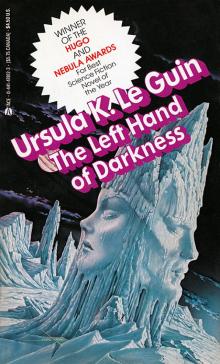 The Left Hand of Darkness
The Left Hand of Darkness The Farthest Shore (Earthsea Cycle)
The Farthest Shore (Earthsea Cycle) The Matter of Seggri botw-2
The Matter of Seggri botw-2